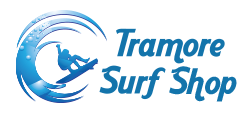Nothing is more important to the new surfer than choosing their first board. Those thin, narrow rockets the big names are riding sure look exciting, but they are a disaster for surfers learning initial techniques. Therefore, keep these tips in mind when choosing your first surfboard.
Rent Before You Buy
At Tramore Surf Shop and School we always recommend you learn to surf first on our rental foamy surfboards. We also have these for sale when you're ready to take the next step. Depending on the speed of your progression these are good for your first few times surfing, after this you should feel confident enough to catch a small wave and get to you feet.
Your First Surfboard Should Be Cheap
While learning how to surf, you're most likely going to ding and scratch a board if you really putting it to good use - so don't spend too much cash. A €700 surfboard will ding as easy as a €400 surfboard. It's not about looks, so ignore the design or brand initially.
If you purchase a second hand board be aware that dings which show foam or any removal of lamination should be avoided.
Your First Surfboard Should Be Big And Thick
All the cool guys and girls have small, narrow surfboards, right? So what! You're not cool yet, you're still learning! Get a board that will give flotation and allow for easy paddling - it'll make learning easier.
A good size board for a beginner surfer would be around 7 feet long and 19-21 inches wide and at least 2-3 inches thick. This all depends on your size, so be sure you can comfortably carry and wield the surfboard in the water. Just make sure your surfboard stands at least a foot taller than you.
Generally, an 8 stone surfer should look for a 6 foot 10 inch board while a 10 stone surfer might look towards a 7 foot 2 inch board. At 13 stone, try to go above 7 foot 6 inches.
Don't Worry About Surfboard Shape
Don't worry about the tail shape or number of fins on your surfboard.
These parts of a surfboard don't matter for the time being. For the first 3-6 months, you really shouldn't worry about turning or doing manoeuvres, so whether your surfboard is a swallow tail, pintail or only has one fin is really pointless.
For the record, 3-fin boards are the easiest to turn and the most functional fin set up for the advanced and intermediate surfer.
Final Thoughts...
These are the most basic rules for choosing your first surfboard. It's always best to ask someone who can help, and all of the staff at the surf shop are fully trained and ready to help with any queries. This is why we always recommend dropping by and having a chat with us - we have a large range of boards and can show you through which boards would suit you best.
Our online shop also has video descriptions for all our NSP and Escape surfboards to aid you in your first purchase!
 Free Delivery Over €70
Free Delivery Over €70 See Our Reviews
See Our Reviews